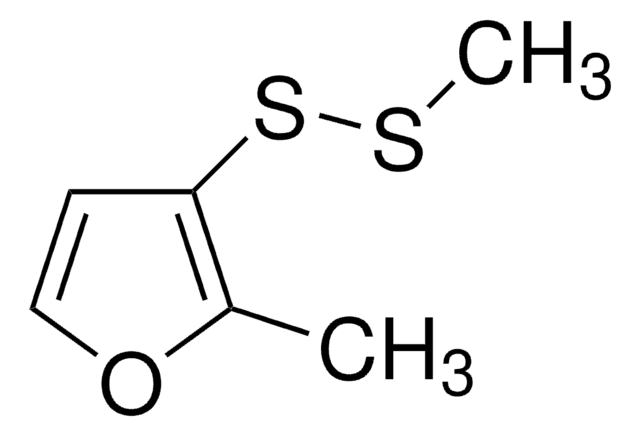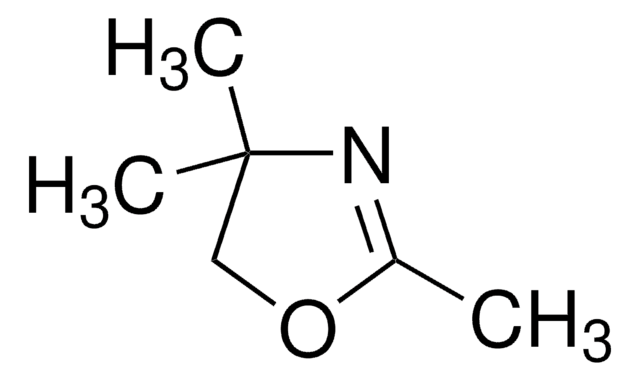Kluczowe dokumenty
W325900
Bis(2-Methyl-3-furyl) disulfide
98%, FG
Synonim(y):
2-Methyl-3-furyl disulphide; 3,3′-Dithio-2,2′-dimethyldifuran
About This Item
Polecane produkty
pochodzenie biologiczne
synthetic
Poziom jakości
klasa czystości
FG
Halal
Kosher
agency
meets purity specifications of JECFA
zgodność regionalna
EU Regulation 1334/2008 & 872/2012
FDA 21 CFR 110
Próba
98%
współczynnik refrakcji
n20/D 1.576
bp
280 °C
gęstość
1.211 g/mL at 25 °C
Zastosowanie
flavors and fragrances
Dokumentacja
see Safety & Documentation for available documents
alergen pokarmowy
no known allergens
Organoleptyczne
meaty; sulfurous
ciąg SMILES
Cc1occc1SSc2ccoc2C
InChI
1S/C10H10O2S2/c1-7-9(3-5-11-7)13-14-10-4-6-12-8(10)2/h3-6H,1-2H3
Klucz InChI
OHDFENKFSKIFBJ-UHFFFAOYSA-N
Powiązane kategorie
Opis ogólny
Zastosowanie
- Decoding the interaction mechanism between bis(2-methyl-3-furyl) disulfide and oral mucin.: This study explores the interaction of bis(2-methyl-3-furyl) disulfide with oral mucin, providing insights into how this compound may influence flavor perception in food products. Understanding these interactions helps in developing food products with optimized sensory profiles, crucial for the food industry (Xi et al., 2024).
- Generation of Meaty Aroma from Onion (Allium cepa L.) with Polyporus umbellatus: Fermentation System, Sensory Profile, and Aroma Characterization.: This research uncovers the potential of bis(2-methyl-3-furyl) disulfide in enhancing the meaty aroma of onions when fermented with Polyporus umbellatus. This novel approach to flavor enhancement could revolutionize culinary applications and offers new avenues for natural flavoring in vegetarian and vegan food products (Stöppelmann et al., 2023).
Hasło ostrzegawcze
Danger
Zwroty wskazujące rodzaj zagrożenia
Zwroty wskazujące środki ostrożności
Klasyfikacja zagrożeń
Eye Dam. 1 - Skin Irrit. 2
Kod klasy składowania
10 - Combustible liquids
Klasa zagrożenia wodnego (WGK)
WGK 3
Temperatura zapłonu (°F)
>230.0 °F - closed cup
Temperatura zapłonu (°C)
> 110 °C - closed cup
Środki ochrony indywidualnej
Eyeshields, Gloves, type ABEK (EN14387) respirator filter
Wybierz jedną z najnowszych wersji:
Masz już ten produkt?
Dokumenty związane z niedawno zakupionymi produktami zostały zamieszczone w Bibliotece dokumentów.
Klienci oglądali również te produkty
Nasz zespół naukowców ma doświadczenie we wszystkich obszarach badań, w tym w naukach przyrodniczych, materiałoznawstwie, syntezie chemicznej, chromatografii, analityce i wielu innych dziedzinach.
Skontaktuj się z zespołem ds. pomocy technicznej











